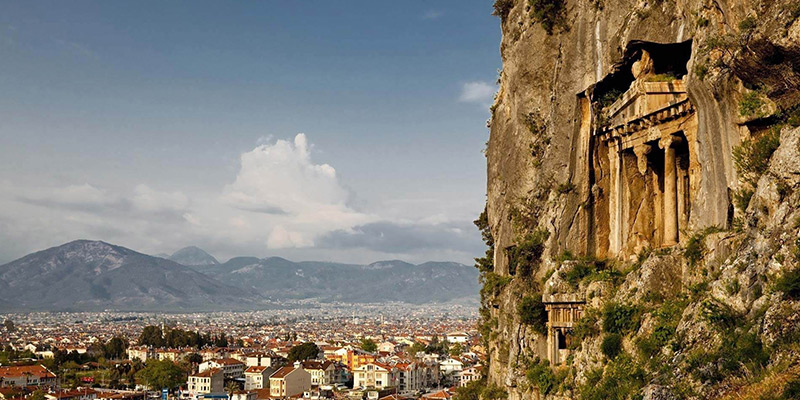Lycia… The land between Antalya and Dalaman stream, where the most magnificent of the tombs carved into the rock from 3000 years ago are located. These unique Lycian rock tombs tell us the life stories and immortality efforts of centuries.
Immortality has existed in the thoughts of human beings not only today, but a very long time ago. While knowing that every living life eventually come to an end, the immortality concept has existed in the history of humanity. The biggest reflection of the desire of immortality is the thought and belief of returning to life after death.
Since 5000 years ago in Anatolia, they have started to organize rock tombs that will serve their later lives. According to the culture, the importance and wealth of the deceased in social life, large, small, simple showy tomb structures have begun to be built. Although the biggest, old and magnificent Egyptian Pyramids, it makes the rock tombs of Lycia more modest but elegant and incompatible with nature and in harmony with it.

The history of Lycian Rock Tombs
Lycia has a special place in freedom and independence throughout its history. They always protected their language and fought against foreign invasions. Lycia was the region where the Roman Empire last approved their rule in the region.
Until recently, the old bright periods were forgotten, but they were rediscovered in the 18th century with the awareness of foreign travelers and archaeologists. Stone processing techniques, which they developed within the framework of their original cultures in the city of and around the ancient Xanthos, were reflected in the monumental tombs as well as the cities. The Lycian Rock Tombs reaching the temple dimensions wherever they are in hard-to-reach places on the slopes of the mountains and valleys are the most intense before the 4th century BC.
The first architecturally remarkable features of the Lycian Rock Tombs are the architrave (stone plinth on the column below the pediment) and the triangle pediment on the form of two Ionic-style columns on the facade. The grave chamber was carved into the rock between these two columns. Stone benches formed on the walls of the burial chamber were used for the deposits of the dead and the altars made to them. The size of the burial chamber and the visible facade changes according to the social and economic power of the deceased.
One of the most important proofs of the richness of the ancient Lydian is the items left to the Lycian stone tombs in order to be used in the later lives of the dead. These rich items and gifts are narratives about the warnings and prophecies they made as a precaution against the robbery that grave thieves could make later. If a person tries to rob these rock tombs, they will be told how the gods will be punished in torture. During the Lycian period, severe penalties were imposed against these kinds of Grave robbery. In general, the Lycian people did not harm the Rock Tombs due to this fear of punishment and also respect for their dead, but with all these measures, grave robberies could not be prevented.
In addition, in Lycian Rock Tombs built for important people of this type, there are rock reliefs on the front facade, pediment and walls in the tomb chamber. The most common theme in these Lycian Rock Tombs is the description of the symposium describing the funeral dinner and seronomy. In addition to the relief Symposium descriptions, the heroic stories and the theme of Bellerophon and Chimaira, which occupy a unique place in ancient mythology, are studied. According to this mythology, the hero Bellerophon is told to save the people by fleeing the three-headed monster Chimaira with the famous winged horse Pegasus of ancient mythology.
The construction of Lycian Rock Tombs continued for centuries. Many of them have formed very close groups. In some groups, rock tombs were built so close to each other that today it amazes people. Together with the birds flying around the slopes, they resemble bird nests, the numbers of which can be expressed in faces. The secret of today’s fame of Lycian Stone Tombs also lies in how harmoniously integrated with this natural environment.
The best way to understand the Lycians who carry their own culture and richness with the rock tombs at the level of artifacts they carved on the rocks can be with their visits to this region. Until recently, the perfect route for the region, which is difficult and difficult to reach by road, is to use one of the most beautiful walking routes in the world, the Lycian road. Among the evidences of extraordinary nature and ancient culture, this magnificent 550-kilometer route extending to Muğla, Fethiye district Ovacık, Antalya Geyikbayırı village will be an amazing experience where you can see Lycian Rock Tombs, Lycian culture and the Roman period.
You can click Antalya Waterfalls.

